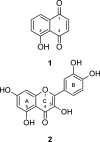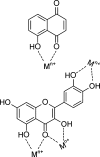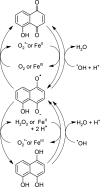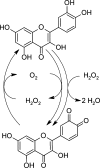Simultaneous detection of pro- and antioxidative effects in the variants of the deoxyribose degradation assay
- PMID: 20108920
- PMCID: PMC2823302
- DOI: 10.1021/jf902395k
Simultaneous detection of pro- and antioxidative effects in the variants of the deoxyribose degradation assay
Erratum in
- J Agric Food Chem. 2012 Sep 5;60(35):8772
Abstract
Interest in the redox properties of natural products has led to the development of various assays for the detection of antioxidant activities and ROS-scavenging properties. Here, additional modifications of the 2-deoxy-d-ribose degradation assay are introduced that specifically allow the determination of interactions of the test compound with the autoxidation of ascorbic acid and the autoxidation of the test compound itself. To illustrate this, juglone and quercetin were used as examples. The modified assay systems provide insights into their specific antioxidative and pro-oxidative properties. In additional, an extensive characterization of the redox properties of their complex with iron is possible, if iron ions are added in the free form or complexed with EDTA. The juglone-iron complex proved to be pro-oxidative in a wider range of milieus than the quercetin-iron complex.
Figures








References
-
- Aruoma O. I.; Bahorun T.; Clement Y.; Mersch-Sundermann V. Inflammation, cellular and redox signalling mechanisms in cancer and degenerative diseases. Mutat. Res., Fundam. Mol. Mech. Mutagen. 2005, 579, 1–5. - PubMed
-
- Valko M.; Leibfritz D.; Moncol J.; Cronin M. T. D.; Mazur M.; Telser J. Free radicals and antioxidants in normal physiological functions and human disease. Int. J. Biochem. Cell Biol. 2007, 39, 44–84. - PubMed
-
- Sen C. K.; Packer L. Antioxidant and redox regulation of gene transcription. FASEB J. 1996, 10, 709–720. - PubMed
Publication types
MeSH terms
Substances
Grants and funding
LinkOut - more resources
Full Text Sources
Medical

